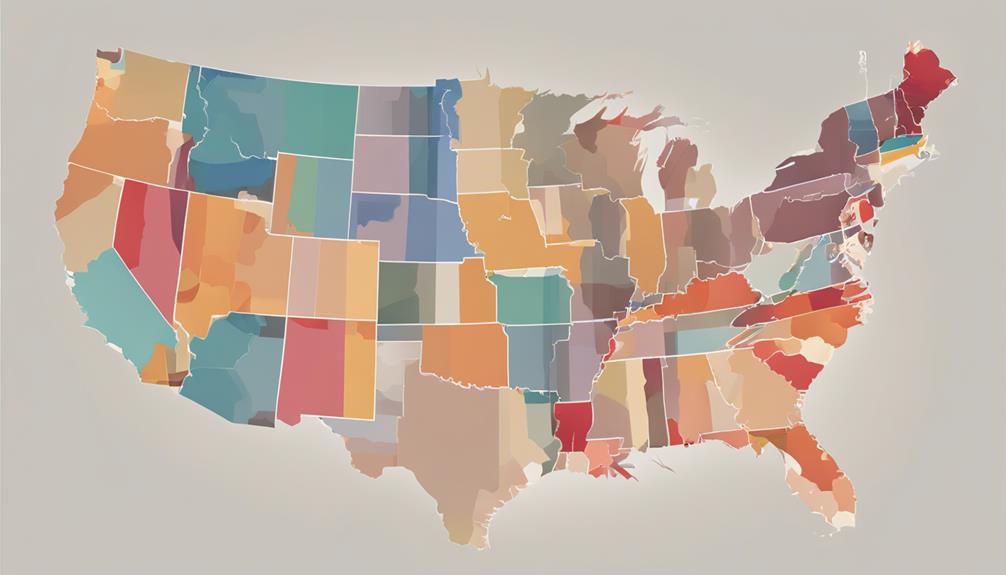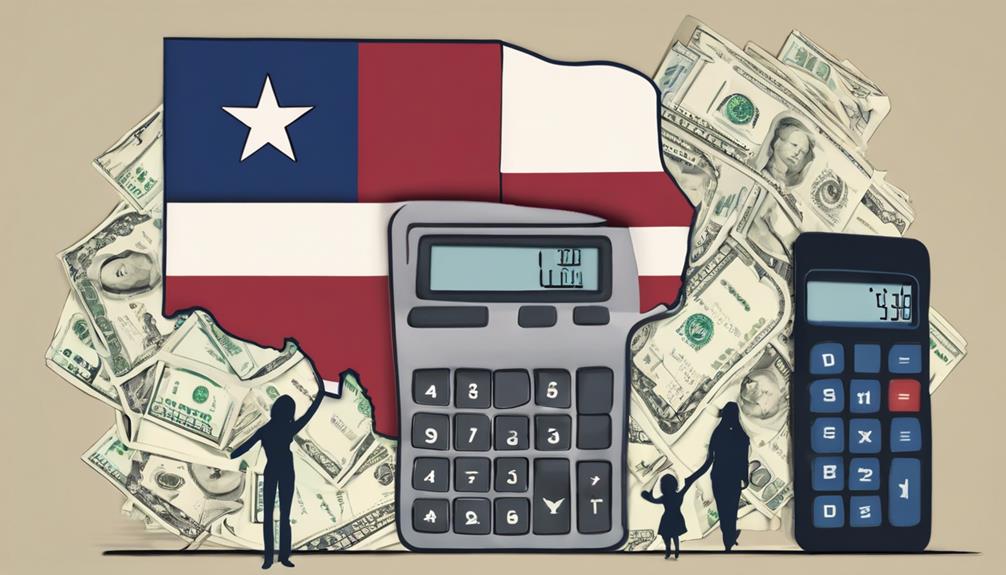Texas divorce statistics demonstrate a significant decline in rates, with a majority of divorces being initiated by women citing “insupportable marriages,” often involving children under the age of 18. Understanding these patterns is crucial in navigating the complexities of family law. Demographic data indicates a higher proportion of divorced women, with changing gender roles affecting the number of divorce filings. Children play a significant role in custody arrangements, with a focus on their well-being under Texas family law. Religious beliefs also impact divorce rates, with variations seen among different Christian denominations. Marriage statistics show younger ages at marriage compared to the national average, emphasizing the impact of divorce rates on financial stability and marital dynamics. To learn more about Texas divorce trends, click here.
Key Takeaways
- Texas has seen a significant decrease in divorce rates over the past decade.
- Women initiate 69% of divorces in Texas.
- Insupportable marriage is the predominant reason for divorce filings.
- Nearly half of divorces in Texas involve children under 18.
- Understanding these trends aids in navigating complexities of family law.
Divorce Rates in Texas
We've noticed a significant decrease in divorce rates in Texas over the past decade, falling from 3.3 per 1,000 population in 2010 to a mere 1.4 in 2021. This decline reflects a changing trend towards more stable and enduring marriages in our state.
Women initiating 69% of divorces in Texas indicates a growing empowerment and readiness to seek freedom from unhappy marriages.
The predominant reason for divorce being an insupportable marriage shows a shift towards a no-fault approach, focusing on the irreparable breakdown of the relationship rather than assigning blame.
With almost half of divorces involving children under 18, it underscores the importance of handling divorces with care, especially in families with minor children.
Understanding these divorce rates and trends can help individuals navigate the complexities of family law, ensuring a smoother shift during such challenging times.
Demographics and Trends

After observing the divorce rates and reasons for divorce in Texas, it becomes evident that demographic trends play a significant role in shaping the landscape of marital dissolution in the state. In Texas, divorced women outnumber divorced men, with percentages ranging from 11.3% to 12.3% from 2014 to 2021. Women initiate over half of divorces in Texas, accounting for nearly 70% of divorces nationwide. The primary reason for divorce filings in Texas is insupportability, indicating a breakdown in the marriage.
- Higher Percentage of Divorced Women: The demographic trends in Texas show a higher percentage of divorced women compared to men, highlighting a shift in traditional gender roles within marriages.
- Initiation of Divorces: Women taking the lead in initiating divorces challenges stereotypes and reflects changing dynamics in marital relationships.
- Insupportability as a Major Factor: The prevalence of insupportability as the primary reason for divorce filings signifies a widespread dissatisfaction and breakdown in marriages across the state.
Children and Divorce in Texas
Children play a pivotal role in the complexities of divorce proceedings in Texas, influencing key decisions on custody and support arrangements. In nearly half of divorces in Texas involving children under 18, considerations for child custody and support are paramount, with courts prioritizing the best interests of the child.
Post-divorce, over 40% of women in Texas take on guardianship responsibilities, underscoring the significance of mothers in child custody arrangements. Texas family law places a strong emphasis on child well-being during divorces, necessitating detailed parenting plans and visitation schedules to address the needs of the children involved.
The presence of children adds layers of complexity to legal proceedings, requiring thorough attention to guarantee a smooth handover for the entire family. Making sure that the children's best interests are met stands as a cornerstone in divorces involving children in Texas, highlighting the importance of carefully crafted custody and support arrangements to promote stability and security for the children.
Religious Influences on Divorce

In Texas, the influence of religious beliefs on divorce rates is a significant factor to take into account, especially with the notable differences between religious and non-religious couples in the state. When examining the impact of religious influences on divorces among Texas residents, several key points emerge:
- Christian Denominations Vary: Different Christian denominations in Texas exhibit varying divorce rates, showcasing the diverse landscape of marital stability within religious communities.
- Strong Religious Beliefs Foster Stability: Strong religious beliefs and practices can contribute to marital stability in Texas, highlighting the positive role faith plays in maintaining healthy marriages.
- Guidance and Values Matter: Religious guidance and values often play a significant role in reducing divorce rates in Texas, emphasizing the importance of shared beliefs and principles in sustaining marriages.
These factors underscore the intricate relationship between marriage, religious beliefs, and divorce statistics, offering valuable insights into the dynamics at play within the Texan community.
Marriage Statistics and Trends
Marriage statistics and trends in Texas reveal valuable insights into the demographics and dynamics of marital unions within the state. Texas individuals typically marry at a younger age than the national average, with men marrying at a median age of 28.5 and women at 26.6. Second marriages in Texas last around 17 years on average, while third marriages have a median duration of 13 years. In 2019, Texas saw 174,850 marriages, indicating ongoing trends in marriage rates. Understanding these statistics can shed light on the marital landscape in Texas, including aspects such as financial stability, marital property, and the median age at marriage. The state's divorce rate, influenced by factors like no-fault divorce and fault-based grounds, plays a significant role in shaping the dynamics of Texas couples and families.
| Marriage Statistics | Trends in Texas |
|---|---|
| Median Age at First Marriage | Men: 28.5, Women: 26.6 |
| Second Marriage Duration | 17 years |
| Third Marriage Duration | 13 years |
| Marriages in 2019 | 174,850 |
| Impact of Divorce Rate | Financial Stability |
Frequently Asked Questions
What Are the Statistics on Divorce in Texas?
We'll share the statistics on divorce in Texas. The state had a divorce rate of 1.4 per 1,000 in 2021, with women initiating 69% of divorces. Irreconcilable differences are a common reason, impacting families with children to a notable extent.
What Is the No 1 Predictor of Divorce?
Contempt, a corrosive force in relationships, proves the top predictor of divorce. Disrespect, sarcasm, and belittling behaviors eat away at love. Eliminating contempt through communication and mutual respect can save unions from dissolution.
What Is the Biggest Divorce Predictor?
Marrying young is the biggest divorce predictor. Research shows that tying the knot before 25 increases divorce chances. Education levels, previous marriages, and cohabitation also influence divorce rates. These factors impact marital success profoundly.
What Is the 10 Year Rule in Divorce in Texas?
Perplexing and pivotal, the 10 Year Rule in Texas divorce dictates the potential for spousal maintenance after a decade of marriage. It offers support based on need, aiming to assist the disadvantaged spouse.
What are the common reasons for divorce in Texas according to the Texas Divorce Statistics?
According to the Texas Divorce Statistics, some common reasons for divorce in Texas include infidelity, financial stress, communication issues, and a lack of commitment. Navigating contested divorce in Texas can be challenging, but with the right legal guidance, couples can work towards achieving an amicable resolution.
Conclusion
As we explore the complex web of Texas divorce statistics, it becomes clear that the numbers paint a vivid picture of the intricacies and realities of marital relationships in the Lone Star State.
From increasing divorce rates to changing demographic trends, the data offers a window into the diverse experiences of individuals maneuvering the legal landscape of divorce.
These statistics serve as a powerful tool for understanding the dynamics of marriage and separation in Texas, guiding us towards informed decisions and insights.










